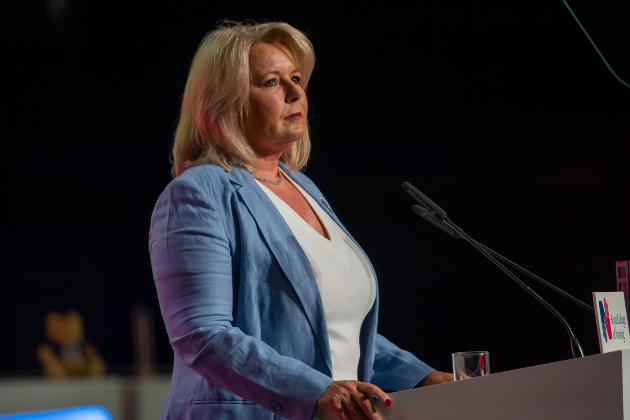It can be hard to contemplate the future while confronting the daily reality of serious illness. But RCN member Val Peddie specialises in encouraging patients to think ahead.
Val is a senior charge nurse and fertility specialist at Aberdeen Centre for Reproductive Medicine. Part of her role involves working with young people diagnosed with cancer whose fertility is threatened by chemotherapy, radiotherapy or other medical conditions, and for whom preservation of eggs, sperm or embryos prior to treatment may be a viable option.
The work is complex. It is undertaken within a strict legal framework governing the storage and use of gametes and embryos, and requires expert handling of highly emotive issues.
Val, a former chair of the RCN Fertility Nursing Forum, says that for men cryopreservation of sperm – freezing in liquid nitrogen – is relatively straightforward, although it still involves specialist input in terms of counselling, giving information and gaining informed consent.
I see it as a positive part of cancer care
For women or young girls, however, fertility preservation is more complex.
Val says: “It requires a period of medical intervention separate from the cancer treatment patients are already going through.”
In the past, health care professionals were focused primarily on survival, and it has taken time for fertility preservation to become established as a quality of life choice.
But successful treatment of primary disease is now more commonplace, to the point where storage of eggs or embryos is an option.
“I see it very much as a positive part of cancer care – an insurance policy,” says Val. “Now we’re talking about life after cancer and family planning, instead of ‘if I survive cancer’.”
Broaching the subject
With young girls in particular, for whom starting a family is a remote idea, broaching the subject of harvesting and freezing eggs requires knowledge, experience and, above all, understanding.
But non-specialists have a key role to play in alerting fertility experts such as Val that a patient in their care may want to consider preservation.
“We don’t know who’s been admitted to an oncology ward and what their diagnosis and prognosis is,” says Val.
“We rely on timely communication from the oncology and haematology teams, and the non-specialist nurse may be the first point of contact for these patients.”
She recalls research she undertook some time ago where one of the young women she interviewed mentioned that a volunteer massage therapist asked whether the woman had considered fertility preservation ahead of her chemotherapy treatment. “Medical staff had not discussed it with the patient,” Val says.
“But that’s going back a few years and I do think things have changed now.”
Even so, raising awareness of fertility preservation among other professionals is another important part of her role.

Considering consent
One of the youngest girls to be guided through the process by Val and the team in Aberdeen was only 14 and “extremely sick”.
There was a lot to consider, not least the girl’s mother who, Val felt initially, was more enthusiastic about pursuing fertility preservation than her daughter was.
“I had to be clear in my own mind that this was what the young girl wanted to do. Given the severity of her condition, her mother was with her throughout, therefore it was difficult to talk to the girl on her own, yet I thought it unethical and immoral to accept her onto the fertility preservation programme without fully informed consent.”
Caring for adolescents requires additional ethical and moral consideration
Over several days, Val built a trusting relationship with both the mother and the girl, who had a degree of maturity for her age and wanted to avoid future regret. Plans for fertility preservation went ahead.
As the girl was not sexually active, trans-vaginal egg collection required general anaesthesia in the labour ward theatre – an alien environment for any young girl, so timing and access to theatre involved multidisciplinary planning.
“While fertility treatment should always be provided within an empathetic and sensitive environment, caring for adolescents requires additional ethical and moral consideration,” Val says.
Guidance to support practice
RCN guidance on fertility preservation published last year highlights the complexities of egg retrieval.
For about a fortnight, the patient must self-administer daily injections of a hormone designed to stimulate the development and maturity of eggs within the ovarian tissue.
The egg collection procedure that follows can be performed under general anaesthetic or conscious sedation, as is usual practice in Aberdeen, and involves attaching a needle guide to a vaginal ultrasound probe. Using ultrasound to locate the ovaries, the needle is advanced into each follicle within the ovarian tissue. Gentle suction is applied to remove the follicular fluid, together with the egg within the follicle.
Although outcomes in many life-limiting illnesses have improved, there are no guarantees of survival. Therefore the process of fertility preservation also involves establishing the patient’s wishes if treatment of the primary diagnosis is unsuccessful.
We try to turn it round and say we’re not asking because you are living with a cancer diagnosis – it’s because we’re storing material that has the potential of life
“People considering freezing eggs, sperm or embryos are asked what they would want to happen to their gametes in the event of mental incapacity or death,” Val says.
“It’s dreadful to ask someone to consider their own mortality, but what we say is, ‘We ask all our fertility patients the same thing. Legally, we need to know what you want us to do with your eggs if you are no longer able to consent’.”
She adds: “We try to turn it round and say we’re not asking because you are living with a cancer diagnosis – it’s because we’re storing material that has the potential of life.”
In fertility nursing, Val’s role is unusual because she rarely hears about the long-term outcome for her patients. As she says, she may be retired by the time some of her younger patients become parents. But she is permitted to access the local electronic patient management system to check on patients’ progress and whether, for example, their primary diagnosis has led to relapse or readmission.
“Cancer survival statistics are usually expressed in one, five and 10 year periods. Where patients reach five years without relapse, this is extremely encouraging, and if they have eggs, sperm or embryos in storage, in my opinion that’s a success,” she says.
Fertility preservation in practice
Mary’s teenage daughter Imogen* was admitted to hospital in March this year with what turned out to be severe aplastic anaemia, a serious condition for which bone marrow transplant is a treatment option.
The initial plan was for Imogen to be given chemotherapy in preparation for the transplant, if a suitable donor could be found.
Mary and Imogen met specialist fertility nurse Val when Imogen was transferred to Aberdeen within days of diagnosis.
“Obviously, it was a very shocking time for us,” says Mary. “I didn’t realise to start with that she may need chemotherapy but once the penny dropped and they explained that they would look at preserving fertility they introduced us to Val.
"Fertility preservation hadn’t even crossed my mind at first. All you care about is the fact that your child is very seriously ill. But I thought it was a fantastic idea.
“Val explained everything to us, what the procedures would be, and she involved my daughter fully in all the discussions.”

For Mary, the actual process of fertility preservation proved draining. “I found it very upsetting personally – the thought of your child having to go through this. It’s a very emotional thing for both the child and the parents.”
After the egg recovery, there were complications. At home, two hours’ drive from Aberdeen, Imogen developed severe pain and was readmitted as an emergency with hyperstimulation of the ovaries.
Val explains that given Imogen’s diagnosis, she was prescribed progesterone therapy to avoid unnecessary bleeding. But this was counterproductive in that it prevented Imogen from having a period, which would have lowered her hormone levels sufficiently to reduce the risk of hyperstimulation.
So aside from her primary diagnosis, Imogen went through a great deal, Mary says. “It’s not plain sailing.” Nonetheless, she says her daughter is glad she opted for fertility preservation.
In the event, Imogen’s siblings proved not to be suitable bone marrow donors so immunotherapy is being explored instead, in which case she won’t require chemotherapy. “But we have the fertility preservation as an insurance,” Mary says.
Looking back, she says of her daughter’s fertility preservation: “It’s very, very positive – but it’s also emotional and upsetting. At the end of the day, though, you get through it.”
She adds: “And Val is absolutely brilliant. She’s so kind and so good at what she does.”








